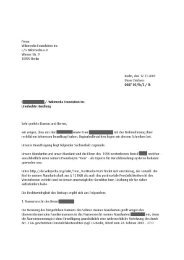Proceedings
Proceedings
Proceedings
You also want an ePaper? Increase the reach of your titles
YUMPU automatically turns print PDFs into web optimized ePapers that Google loves.
| 80<br />
vncrypt 3 project is an example that takes this approach.<br />
�������������������������<br />
The idea is that the user can decide for each file individually, whether and how it is to be<br />
encrypted. This has the following implications:<br />
� CPU cycles can be saved on data that the user decides is not worth the effort.<br />
This is an advantage, since encryption requires a lot of processing power. It also<br />
allows the user to choose different keys for different files (although reality<br />
usually reflects the opposite phenomenon).<br />
� Meta data is not encrypted. Even if the file's contents are sufficiently protected,<br />
information such as file name, ownership, creation and modification date,<br />
permissions and size are still stored in the clear. This represents a risk which is<br />
not to be underestimated.<br />
The usability of in-storage encryption largely depends on how transparent the<br />
encryption and decryption process is performed to the user. In order to minimize user<br />
interaction, the relevant system calls must be modified to perform the cryptographic<br />
functions accordingly. That way, neither the user nor the applications must make any<br />
additional effort to process encrypted file content, since the kernel will take care of this<br />
task.<br />
If system call modification is not going to take place, any program required to<br />
process encrypted data must either be modified to perform the necessary cryptographic<br />
functions itself or it must rely on an external program for that task. This conversion<br />
between cipher text and plain text – and vice versa – is hardly possible without requiring<br />
any user interaction.<br />
Scenario: file-based encryption of huge files<br />
The file might be a database or multimedia container: if the cryptographic functions<br />
are not performed on-the-fly (usually through modified system calls), the entire file<br />
content must be temporarily stored in plain text – therefore consuming twice the space.<br />
Then the unencrypted copy must be opened by the application. After the file has<br />
been closed, it obviously must be encrypted again – unless no modification has taken<br />
place. The application will therefore save the data in plain text, which must then be<br />
encrypted and written out in its cipher text form again – but by a program capable of<br />
doing the appropriate encryption.<br />
The unencrypted (temporary) copy could of course just be unlinked (removed from<br />
the name space), but in that case the unencrypted data would still remain on the<br />
medium until physically completely overwritten. So, if one wants to really destroy the<br />
temporary copy, several overwrites are required – which can consume a lot of time with<br />
large files. Therefore, a lot of unnecessary I/O must be performed.<br />
Scenario: file-based encryption of many files<br />
If one wants to encrypt more than just a small bunch of files, it actually does not<br />
matter how small or large they are – the procedure described above still must be adhered<br />
to unless encryption and decryption is performed on-the-fly.<br />
Aside from its lack of scalability, file-based encryption also suffers from the leakage<br />
3 http://sourceforge.net/projects/vncrypt/<br />
-4-






